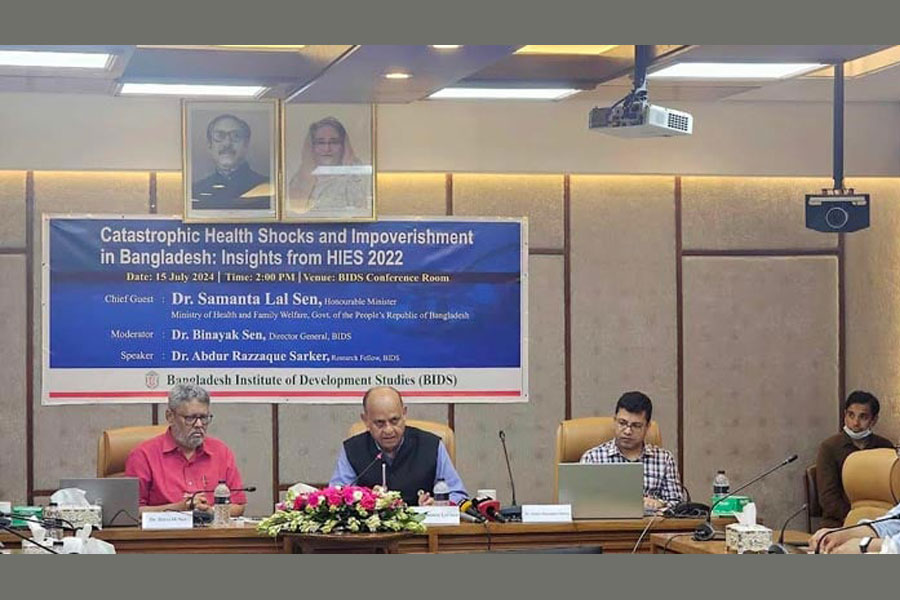Out-of-pocket health spending pushed 6.13 million people below poverty line in 2022: Study

Published :
Updated :

Talks will be meaningless until quality health service is ensured in rural areas, said the health minister as a study showed financial hardship is worsening in the country due to the increase in out-of-pocket health spending.
Around 3.7 per cent of the population, equivalent to 6.13 million people, was pushed below the national poverty line in 2022, while about 61 per cent of people faced financial distress due to hospitalisations, according to the Household Income and Expenditure Survey 2022 (HIES).
“I believe that if I cannot ensure proper health care of the people at the marginal level, no matter how much I sit and give lectures in Dhaka, it will be of no use. I give top priority to improving health care in rural and marginal areas,” Health and Family Welfare Minister Dr Samanta Lal Sen said.
The minister made the remarks as the chief guest at a seminar titled, 'Catastrophic Health Shocks and Impoverishment in Bangladesh: Insights from HIES 2022' organised by the Bangladesh Institute of Development Studies (BIDS).
Binayak Sen, Director General of BIDS, presided over the seminar. The main presentation was delivered by Abdur Razzaque Sarker, Research Fellow, BIDS.
Speaking at the event, the health minister said that he had inspected the health services of North Bengal in detail for the past forty-eight hours, including health complexes, district hospitals, and community clinics in Panchagarh, Dinajpur, Thakurgaon, Nilphamari Upazila.
Dr Sen said he found worrying levels of hypertension and diabetes patients up to 60 per cent. He, however, said the health ministry was providing medicine to the rural patients.
“If we can provide proper treatment and medicine for blood pressure, diabetes then there will be no need for big specialised hospitals in Dhaka city,” he added.
He also suggested taking projects that will benefit people, such as cancer hospitals, kidney hospitals, heart hospitals, etc. “I aim to ensure proper treatment of Burn Unit, Cancer, Cardiac, Nephrology in every divisional city.”
“It is not possible for a poor person to come from Rangpur to Dhaka for dialysis […]. Many things can be done if we take advantage of the allocation given in the health sector,” the minister continued.
Regarding the indiscriminate use of antibiotics, the health minister said that antibiotics are being used if there is a slight cold and fever without a prescription.
“We are trying to introduce a digital prescription system to stop the sale of antibiotics without prescription. If an electronic prescription system can be introduced then proper monitoring will be possible, arbitrary and excessive use of drugs can be controlled,” he said.
Bangladesh is committed to achieving Universal Health Coverage (UHC) to ensure healthcare for all, the health minister said, promising to introduce the UHC in the country.
But it would take time, he said.
Abdur Razzaque Sarker in his presentation based on HIES said people in Bangladesh have the highest 77.2 per cent Out-of-pocket (OOP) expenditure among the South Asian nations after Afghanistan. Even Pakistan has better OOP than Bangladesh.
Meanwhile, the cost of medicines is the major driver both for outpatients and hospitalisation cases.
From the marginal effect analysis, it was found that households with at least one hospitalisation case incurred an incremental out-of-pocket of BDT 55,134 compared to households with no hospitalisation cases.


 For all latest news, follow The Financial Express Google News channel.
For all latest news, follow The Financial Express Google News channel.